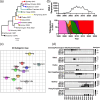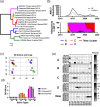The saga to monitor and control norovirus: the rise of GII.17
- PMID: 40476850
- PMCID: PMC12282288
- DOI: 10.1099/jgv.0.002118
The saga to monitor and control norovirus: the rise of GII.17
Abstract
Norovirus is a major cause of acute gastroenteritis in all age groups, with recent surges of cases in Europe and the USA reinforcing the influence of this virus on human health. Despite its societal impact, no vaccine or antiviral drug is available. The development of these countermeasures has been impaired at least in part by the extreme genetic and antigenic diversity of noroviruses. Here, we reviewed historical norovirus outbreaks, including the pandemics of GII.4 norovirus that were first documented in the mid-1990s, sporadic increases of non-GII.4 norovirus (e.g. GII.17 and GII.2) during the 2010s and, most recently, the ongoing large outbreaks caused by a new cluster of GII.17 noroviruses. This five-decade-long journey of tracking noroviruses in the human population illustrates the importance and challenges of battling this evolving virus.
Keywords: antigenic diversity; diarrhea; histo-blood group antigen (HBGA); norovirus; virus evolution.
Conflict of interest statement
The authors declare that there are no conflicts of interest.
Figures




Similar articles
-
Molecular epidemiology of noroviruses associated with acute sporadic gastroenteritis in children: global distribution of genogroups, genotypes and GII.4 variants.J Clin Virol. 2013 Mar;56(3):185-93. doi: 10.1016/j.jcv.2012.11.011. Epub 2012 Dec 5. J Clin Virol. 2013. PMID: 23218993
-
Manipulation of immunodominant variable epitopes of norovirus capsid protein elicited cross-blocking antibodies to different GII.4 variants despite the low potency of the polyclonal sera.J Virol. 2025 Jul 22;99(7):e0061125. doi: 10.1128/jvi.00611-25. Epub 2025 May 30. J Virol. 2025. PMID: 40444946 Free PMC article.
-
Multi-Province Outbreak of Acute Gastroenteritis Linked to Potential Novel Lineage of GII.17 Norovirus in Argentina in 2024.Viruses. 2025 Feb 5;17(2):223. doi: 10.3390/v17020223. Viruses. 2025. PMID: 40006978 Free PMC article.
-
Highly variable antigenic site located at the apex of GII.4 norovirus capsid protein induces cross-reactive blocking antibodies in a variant-specific manner.J Virol. 2025 Jul 22;99(7):e0065225. doi: 10.1128/jvi.00652-25. Epub 2025 May 30. J Virol. 2025. PMID: 40444947 Free PMC article.
-
Pooled prevalence and genetic diversity of norovirus in Africa: a systematic review and meta-analysis.Virol J. 2022 Jun 28;19(1):115. doi: 10.1186/s12985-022-01835-w. Virol J. 2022. PMID: 35765033 Free PMC article.
References
-
- Zahorsky J. Hyperemesis hiemis or the winter vomiting disease. Arch Pediatr. 1929;46:391–395.
Publication types
MeSH terms
LinkOut - more resources
Full Text Sources
Medical

